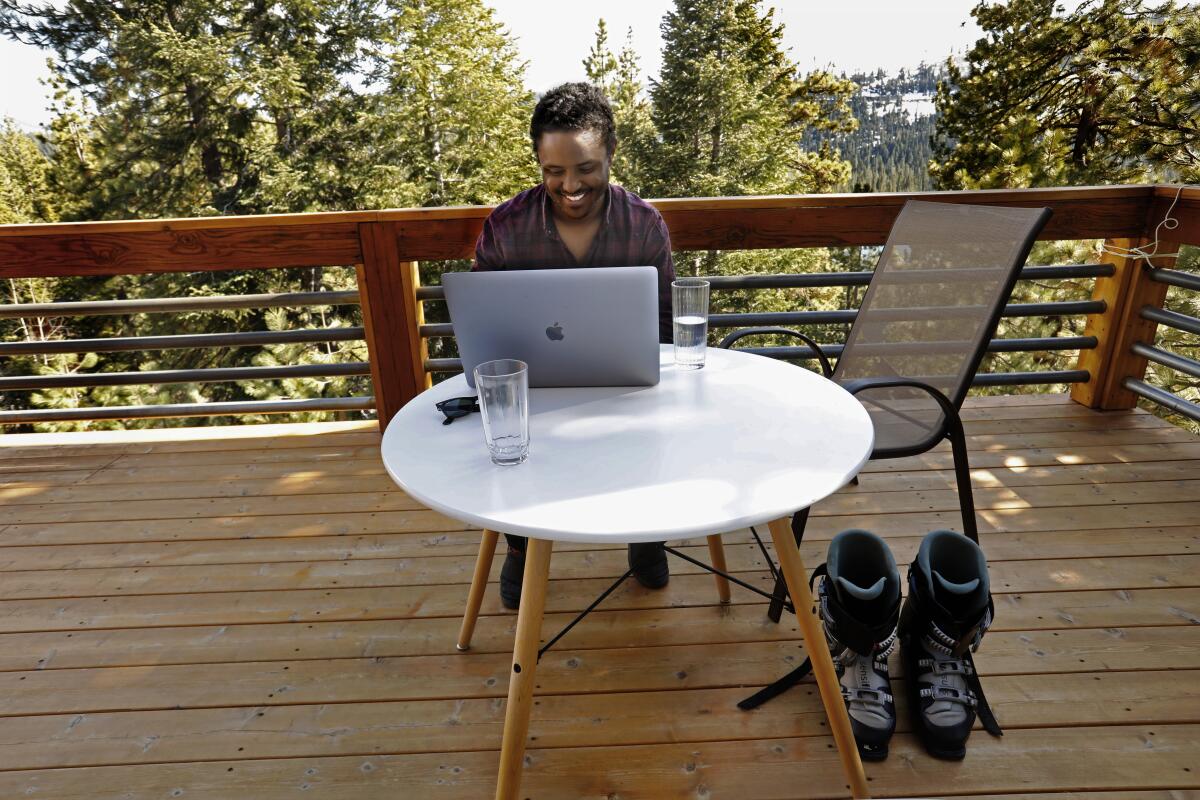Op-Ed: Work life will never be the same. We need some in-person days and some remote

- Share via
Before the pandemic, few people took remote work seriously. Researching the phenomenon for almost 20 years, I frequently heard disparaging comments like “working from home, shirking from home” and “working remotely, remotely working.”
This all changed in March 2020, and we are never going back to the workplace of 2019. Even firms that aggressively pushed in spring 2021 for workers to return to the office, such as Goldman Sachs and JPMorgan, postponed their mandates.
Working from home surged twelvefold between 2017-2018 and May 2020. The pandemic is the biggest shock to American working life since the shift to military production during World War II.
Employees are driving this revolution. Surveys of 50,000 workers across the country find they want to work from home 2.5 days a week on average after the pandemic. Employees working from home frequently tell me how they enjoy the freedom of being able to go to the gym or see the dentist during a week day, making up the work time in the evenings or on weekends. I enjoy the ability to pick up my kids from school on work-from-home days. Employees with young children are the most likely to want to work from home.
As the pandemic has lingered, many of us have become ever more comfortable with remote human interactions. The rapid spread of new coronavirus variants is further undercutting employers’ push for a full-time return.
Indeed, getting employees back to the office is now a major challenge. Companies that want more in-person work will have to overcome some serious hurdles.
First, there’s the labor market. A December survey revealed that more than 40% of U.S. employees would start looking for another job or quit immediately if ordered to return to the office full time. Not surprisingly, then, after Goldman Sachs demanded employees return full-time to the office, the company announced it would raise its starting pay for first-year analysts by nearly 30%. In this new era, if you want employees in the office full time, you have to pay for it.
A subtler issue lurks in workforce diversity. The survey data show that people of color and highly educated women with young children place especially high value on the ability to work from home at least part of the week. One explanation is that they face a less positive in-person workplace environment. Employers that ban working from home will risk driving these employees out the door. Many organizations are striving to improve representation of women and minorities, especially in management. That may turn out to be incompatible with requiring only in-person work.
Environmental concerns should loom large as well. Working remotely cuts pollution from commuting and business travel, given that transportation generates about 30% of greenhouse gas emissions in the U.S.
Finally, time is a finite resource. Remote work saves millions of hours of commuting each week. Traveling to and from work eats away at our collective productivity, in our jobs and in our personal lives. Some data from Europe and North America showed that when people shifted to remote work during the pandemic, they ended up putting in longer hours — not great news for work-life balance, to be sure, but a development that many employers would cheer.
And yet, a lot of bosses want people back in the office.
So what should we do? My advice is to recognize the reality of the new labor market and adapt. Hybrid schedules are the future, with employees averaging three days a week in the office. Tuesdays, Wednesdays and Thursdays, for instance, can be social and highly engaged days full of in-person meetings, events and connectivity. Mondays and Fridays would then be work-from-home days, for quiet work such as reading, writing and smaller remote meetings. Research suggests this hybrid approach increases productivity by 5% on average compared with the full-time in-person model, making this a win-win for companies and employees.
Not everyone will gain from a cultural shift toward working from home. We are now rapidly moving to a three-tier workforce. Research by Jose Barrero, Steve Davis and myself found that about 35% of workers can work at least partly from home. These are usually college-educated professionals and executives. A further 15% percent of a similar demographic can work remotely all the time. But about 50% of all employees have to work fully in-person.
These include people in front-line jobs in retail, manufacturing, healthcare and other service industries. Their positions are frequently lower-paid and don’t require college degrees. Remote work seems to inevitably widen existing disparities in the workforce. Managers around the country have told me they have been raising salaries for front-line employees to compensate, and are trying to increase flexibility of their working hours. A hybrid schedule for those who can work remotely will also help to bridge this divide.
The hybrid model prevents all of us from getting carried away with the shift to remote work. Some executives are understandably enthusiastic about cost savings, but I worry that a cost-driven push for fully remote work could squeeze the joy out of work life, which includes socializing with colleagues and the chance to shore up shared workplace values. Too much working from home, I fear, could also exacerbate an already highly polarized society.
As employers and employees think about when and how to return to in-person work, we should be open to exploring different approaches. CEOs will need to embrace those three hardest words “I don’t know,” because so much still is uncertain. But if we take this opportunity to reexamine the future of work, we might still make something positive out of the pandemic.
Nicholas Bloom is a professor of economics at Stanford University and co-director of the Productivity, Innovation and Entrepreneurship program at the National Bureau of Economic Research.
More to Read
A cure for the common opinion
Get thought-provoking perspectives with our weekly newsletter.
You may occasionally receive promotional content from the Los Angeles Times.










